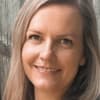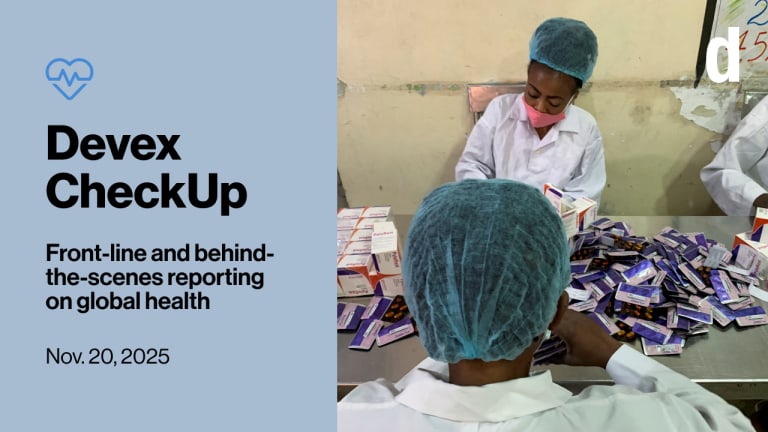The foundation bringing in private sector finance to WHO
Four years after its launch, the WHO Foundation has funneled $24 million to the World Health Organization. It aims to expand the donor base, reduce the administrative work, and align funding with WHO's priorities.
It started with a call with Prince Harry and ended with a multimillion-dollar donation to the World Health Organization’s health response in Ukraine from a wealth management company. The WHO Foundation arranged the call with the U.S.-based ICONIQ Impact, which also included WHO Director-General Tedros Adhanom Ghebreyesus and his deputy, Mike Ryan. And the prince was there to help seal the deal. That’s what the WHO Foundation says it brings to the table — to serve as a convener to reap money from philanthropic organizations, companies, corporate foundations, and the general public for a United Nations agency that has long struggled with sustainable financing. Since its launch in 2020 as an independent Swiss foundation, it’s funneled $24 million to WHO. This is relatively small compared to WHO’s overall proposed budget — which for this year and next is $6.83 billion. However, the foundation also helps in other ways. WHO has argued its relationship with donors can be overly burdensome — it must write more than 3,000 reports to donors each year, consuming a lot of staff time. The foundation says it's stepping in to make the process more seamless as it takes over administrative work, and works to ensure money is aligned with WHO’s priorities. It’s also bringing new donors to the table. Quality and quantity WHO has faced persistent challenges in securing enough flexible funding for its operations, which hinders its ability to allocate resources toward the most pressing global health priorities. While fully flexible funding comes from country membership dues, other funding, which is voluntarily donated, is often short-term grants partly earmarked toward specific programs or country offices. Because of this, there are criticisms that donors play an oversized role in decision-making, and there’s a lack of predictability, creating instability among the organization’s workforce — many of whom are on short-term contracts. When the foundation was launched in 2020, less than 20% of WHO’s budget was flexible. At the time, Tedros called it one of the “greatest threats” to the organization’s success. Since then the world’s countries have agreed to increase the flexibility of the funding they commit, but there are also efforts to ensure other funds flowing in are as flexible as possible. Anil Soni, chief executive officer at the foundation, said Tedros shared with him in the early days of the foundation that its key goals are to improve the quantity and quality of funding. Fully flexible funding is not necessarily going to come from the private sector because philanthropic, corporate donors, and individuals often want to achieve certain outcomes with their money, Soni said. And private funding to WHO — with the exception of the Gates Foundation which is a leading donor — is a small part of the organization’s overall finance. But falling short of fully flexible funding, there are still ways to improve the caliber of funds. And it’s a long game, Soni said. It starts with building relationships with prospective donors and understanding their interests. It then progresses to finding ways those interests can align with WHO’s ongoing work. “Fundraising is not transactional. It's not every week I'm picking up the phone and saying, ‘Hey, will you fund this?’” Soni said. A strong example of this was ICONIQ Impact’s donations to WHO’s work in Ukraine, he said. The wealth management company reached out to the foundation to say the families whom they manage funds for want to help. “That led to very generous contributions,” Soni said, with five families each making about $1 million contribution toward WHO's budget and appeal for Ukraine. “The foundation has supported us since the early days of the full-scale invasion after the 24th of February 2022 with flexible funding, and that allowed us to respond quickly to the matters that were important,” said Dr. Jarno Habicht, WHO representative in Ukraine. The foundation does the back-end work. It crafts the proposals, writes the grant agreements, receives the funding, ensures tax deductibility, and reports back to donors. “If the resources that we are mobilizing are perfectly aligned with WHO's program and we're not asking them to do all of that administrative work — that's a higher quality of funding. Is it earmarked? Yes. But is it still a higher quality of funding? Yes,” Soni said. WHO launched its first investment round last month — bundling its fundraising into a four-year ask as an attempt to ensure predictable funding. It’s asking for $11.1 billion overall — of which it expects country membership dues will reach $4 billion, leaving $7.1 billion for fundraising from governments and the private sector. The foundation aims to raise $50 million of that. This is relatively small, but also a big remit for the foundation — it's twice the amount of money it has contributed to WHO in the four years since its launch. The foundation and WHO have agreed on a prospective list of donors for the foundation to engage with for this fundraising. The right ratio The foundation estimates that for every $3 raised, it spends about $1 on its own expenses. It expects to improve this ratio moving forward as it scales up fundraising while keeping spending steady. The foundation has about 50 staff members with no plans for expansion, Soni said. The foundation is legally separate from WHO and receives no money from it. It also wasn’t created with an endowment or significant seed capital. “We've had to raise both for our organization and for WHO, so that's absolutely been a constraint,” Soni said. The foundation also takes a 10% overhead of a donation because it's responsible for reporting and managing the relationship with the donor, said Reem Abdelhamid-Gazzaz, regional director for philanthropy and partnerships for the Middle East and North Africa region at the foundation. They sometimes waive or renegotiate this if it unlocks a big gift for WHO. But the foundation is also looking for a more sustainable business model so it can wean off fundraising for operational costs, she said. A possible initiative on the foundation’s horizon includes creating an innovation center that focuses on the impact of climate change on health, she said. It will likely be based in the United Arab Emirates, prioritize adaptation, and focus on collaborations among global south countries. “That is really, I would say, the selling point,” she said. “What we're trying to do is really make it as participatory as possible and stemming from the global south.” But initiatives like this could also potentially help with overhead costs, she said. If the foundation serves as the secretariat, it could receive a percentage of the funding. The foundation’s bylaws as a Swiss foundation also allow it to give money to other organizations. For example, during the pandemic, it helped mobilize $20 million to Gavi, the Vaccine Alliance to support the procurement of vaccines. However, it aims to direct about 70% of funds, in any two-year period, to WHO. Conflicts of interest The foundation isn’t required to disclose its donors to the public — one of the reasons being that some donors don't wish to be solicited for further donations. But this has also drawn some concerns around spotting conflicts of interest. Examples of donors that have chosen to be public include Pfizer, Merck, Spotify, Pegasystems, Southwest Airlines, IBM Corporation, Sea Grape Foundation, and the Schwartz Family Charitable Fund. The foundation has also had media partnerships with Vice, Amazon, and Meta, among others. But Soni said the key is ensuring the structure of grant agreements doesn’t lead to a situation where money creates undue influence over the independence of WHO. He also said there are whistleblowing avenues to raise alert about conflicts. Additionally, none of the funds are anonymous to the foundation. “I firmly believe there has not been a single instance of conflict of interest with any grant that we have provided,” Soni said. The foundation is aligned with WHO’s Framework of Engagement with Non-State Actors which means it can’t take money from arms and tobacco industries. Other than that, if a company passes due diligence, theoretically, they can accept it. “But that doesn't mean we will. We still practice our own discretion,” Soni said. “And then WHO can refuse any resources from us.” Big bets and impact In the coming years, Soni said he hopes the foundation engages more in “big bet philanthropy,” which includes bringing many partners on board to tackle big challenges. “Doing more collaborative philanthropic models like this where you can bring philanthropists together and you can bring implementers together — that's a major pillar for us in the future,” he said. He also wants the foundation to expand its work in impact investing. The foundation co-created the Global Health Equity Fund, an impact investment fund that will be managed by venture capital company OurCrowd. It’s committed to sharing a portion of profits from the fund to WHO, through the foundation, as an unrestricted donation. “We have to, as a community, be able to better influence and direct that return-seeking capital,” Soni said. “That's very powerful.” Update, June 13, 2024: This story has been updated to reflect that the WHO Foundation takes a 10% overhead of donations.
It started with a call with Prince Harry and ended with a multimillion-dollar donation to the World Health Organization’s health response in Ukraine from a wealth management company.
The WHO Foundation arranged the call with the U.S.-based ICONIQ Impact, which also included WHO Director-General Tedros Adhanom Ghebreyesus and his deputy, Mike Ryan. And the prince was there to help seal the deal.
That’s what the WHO Foundation says it brings to the table — to serve as a convener to reap money from philanthropic organizations, companies, corporate foundations, and the general public for a United Nations agency that has long struggled with sustainable financing.
This story is forDevex Promembers
Unlock this story now with a 15-day free trial of Devex Pro.
With a Devex Pro subscription you'll get access to deeper analysis and exclusive insights from our reporters and analysts.
Start my free trialRequest a group subscription Printing articles to share with others is a breach of our terms and conditions and copyright policy. Please use the sharing options on the left side of the article. Devex Pro members may share up to 10 articles per month using the Pro share tool ( ).
Sara Jerving is a Senior Reporter at Devex, where she covers global health. Her work has appeared in The New York Times, the Los Angeles Times, The Wall Street Journal, VICE News, and Bloomberg News among others. Sara holds a master's degree from Columbia University Graduate School of Journalism where she was a Lorana Sullivan fellow. She was a finalist for One World Media's Digital Media Award in 2021; a finalist for the Livingston Award for Young Journalists in 2018; and she was part of a VICE News Tonight on HBO team that received an Emmy nomination in 2018. She received the Philip Greer Memorial Award from Columbia University Graduate School of Journalism in 2014.








